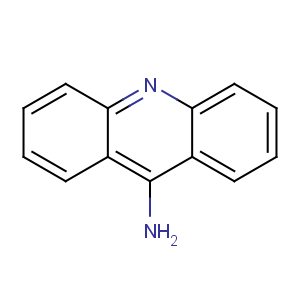Title: Aminacrine
CAS Registry Number: 90-45-9
CAS Name: 9-Acridinamine
Synonyms: 5-aminoacridine; 9-aminoacridine
Molecular Formula: C13H10N2
Molecular Weight: 194.23
Percent Composition: C 80.39%, H 5.19%, N 14.42%
Literature References: Prepn: A. Albert, B. Ritchie,
Org. Synth. coll. vol. III, 53 (1955). Toxicity study: D. C. Brodie, E. Lowenhaupt,
J. Am. Pharm. Assoc. 38, 498 (1949). Spectrophotometric determn in pharmaceuticals: E. A. Bunch,
J. Assoc. Off. Anal. Chem. 66, 140 (1983). DNA intercalator used to induce exptl frameshift mutations: M. Conrad, M. D. Topal,
J. Biol. Chem. 261, 16226 (1986).
Properties: Sulfur-yellow needles from alcohol or acetone, mp 241°. Moderately strong base. pKa (25°): 4.53. Freely sol in alcohol; slightly sol in chloroform, toluene, pyridine; sol in acetone.
Melting point: mp 241°
pKa: pKa (25°): 4.53
Derivative Type: Hydrochloride
CAS Registry Number: 134-50-9
Trademarks: Monacrin (Sterling Winthrop)
Molecular Formula: C13H10N2.HCl
Molecular Weight: 230.69
Percent Composition: C 67.68%, H 4.81%, N 12.14%, Cl 15.37%
Properties: Pale yellow crystals. Neutral reaction. One of the most highly fluorescent substances. One gram dissolves in 300 ml water giving a faintly yellow soln showing bluish-violet fluorescence. LD50 orally in mice: 78 mg/kg (Brodie, Lowenhaupt).
Toxicity data: LD50 orally in mice: 78 mg/kg (Brodie, Lowenhaupt)
Therap-Cat: Antiseptic.
Therap-Cat-Vet: Antiseptic.
Keywords: Antiseptic/Disinfectant; Dyes.

